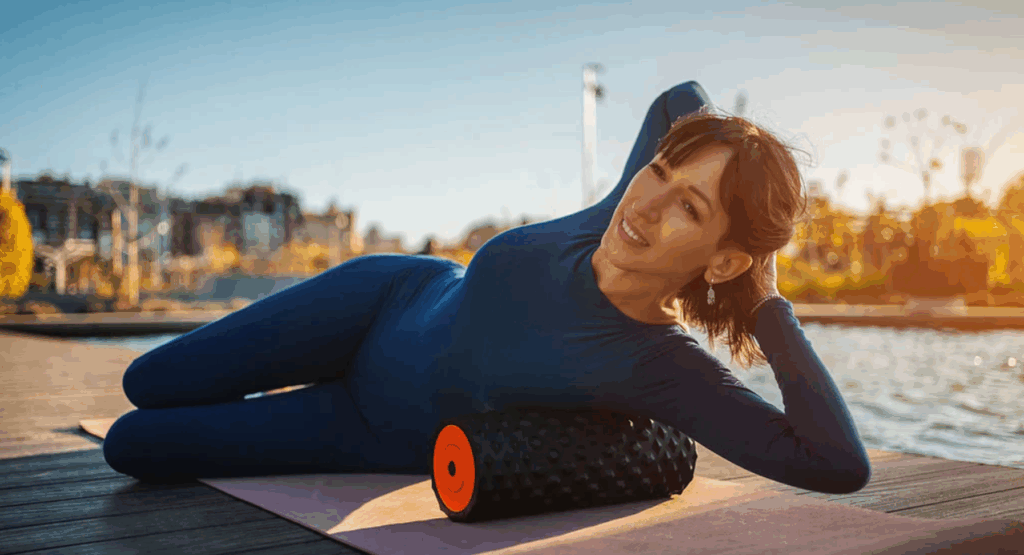Restorative movement counteracts the harmful effects of prolonged sitting by releasing tension, increasing mobility, and strengthening core muscles. Even small “movement snacks” throughout your day can boost energy, enhance mood, and trigger endorphin release while reducing stress hormones. You’ll improve posture, decrease pain, and build resilience against injury when you practice gentle, mindful stretching consistently.
Just 10-15 minutes daily creates sustainable benefits for both your physical body and mental well-being.
Physical Impact of Sedentary Behavior
Technology has made our lives more sedentary, which is bad for our health. Sitting for long periods of time makes it harder to move, weakens your core muscles, and causes bad posture that can lead to chronic pain.
Your body can’t handle being inactive for that long. If you don’t move around a lot, your joints get stiff, your muscles get shorter, and you are much more likely to get hurt when you do move. When your body doesn’t have the basic mobility patterns it needs, even simple injury prevention becomes hard.
The bad effects aren’t just on the body. Being inactive can affect your mood, energy levels, and brain function. The first step to fighting these effects with purposeful, restorative movement practices throughout your day is to understand what they are.

Key Principles of Restorative Movement Practices
Restorative movement is different from high-intensity workouts that push you to your limits. Instead, it focuses on working with your body instead of against it. These practices put mindfulness and intention first, which means they want you to pay attention to your physical sensations instead of ignoring them.
At its core, restorative movement includes gentle stretching that lets go of tension in tight areas without pushing or straining. These practices focus on proper breathing, which helps oxygen flow and turns on your parasympathetic nervous system.
Another important rule is to listen to your body and not push it too hard on any given day. Change your movements as needed and don’t think “no pain, no gain.” Restorative practices put more value on quality than quantity. They stress proper form and alignment over how many times or how long you do something.

Simple Techniques to Incorporate Movement Throughout Your Day
Finding opportunities for movement doesn’t require dramatic lifestyle changes or dedicated workout sessions. Instead, focus on integrating brief moments of intentional movement into your existing routine. Stand up and stretch every 30 minutes when working at a desk, or practice ankle circles during conference calls.
Take the stairs instead of elevators, and park farther from entrances to add natural walking opportunities. Try “movement snacks,” which are two-minute breaks between tasks that stretch your body and mind. You could do shoulder rolls while you wait for your coffee to brew or gentle neck stretches while you talk on the phone to add movement to your day.
Even though these wellness activities are short, doing them regularly adds up to real benefits, such as better posture, less stress, and better energy flow.

How Restorative Movement Affects Mental Well-being
The benefits of incorporating movement throughout your day extend far beyond physical health. When you engage in gentle, restorative activities, you’re activating the parasympathetic nervous system, which naturally counters your body’s stress response.
This mind-body connection works in powerful ways. Restorative movement triggers the release of endorphins and reduces cortisol levels, creating an immediate sense of calm and clarity. You’ll likely notice improved focus, better emotional regulation, and increased resilience to daily stressors.
Even five minutes of mindful stretching or controlled breathing can reset your mental state. Your brain actually changes in response to these practices, strengthening neural pathways associated with attention and emotional processing. This neurological benefit compounds over time, supporting long-term mental well-being alongside physical health.
Building a Sustainable Movement Routine for Long-Term Health
Creating a sustainable movement routine begins with understanding that consistency matters more than intensity. When you commit to daily restorative movement, even just 10-15 minutes, you build a foundation for lasting health benefits rather than experiencing the burnout that often comes with aggressive exercise plans.
Start by identifying times in your day when you naturally have more energy, then schedule your practice during these windows. Focus on developing core stability through gentle, mindful movements that you genuinely enjoy.
Remember that sustainable routines evolve with your changing needs. What works now might need adjustment as your body changes. The key is making restorative movement so integral to your daily rhythm that it becomes as automatic as brushing your teeth.
Frequently Asked Questions
Can Restorative Movement Help With Chronic Conditions Like Arthritis?
Yes, restorative movement can greatly help manage your arthritis. You’ll experience reduced joint stiffness, improved circulation, decreased inflammation, and better mobility when you practice gentle, consistent movements tailored to your condition’s needs.
How Do Restorative Practices Differ Across Age Groups?
Restorative practices vary with age. You’ll need gentler, joint-friendly movements as you age. Children benefit from playful restoration, while adults typically focus on countering work-related strain, and seniors emphasize balance and mobility maintenance.
Is Equipment Necessary for Effective Restorative Movement?
No, you don’t need equipment for effective restorative movement. Your body weight is sufficient for most practices, though simple items like pillows, towels, or a yoga mat can enhance comfort and support.
Can Restorative Movement Replace Physical Therapy?
No, it can’t replace physical therapy. While you’ll benefit from restorative movements in your daily routine, physical therapy offers targeted, professional treatment for specific injuries and conditions requiring clinical expertise.
How Does Weather Affect Outdoor Restorative Movement Practices?
The weather directly impacts your outdoor restorative practices. You’ll need to adapt to temperature, precipitation, and wind conditions. Rain limits mobility exercises, while extreme heat or cold requires shorter sessions and appropriate clothing modifications.





